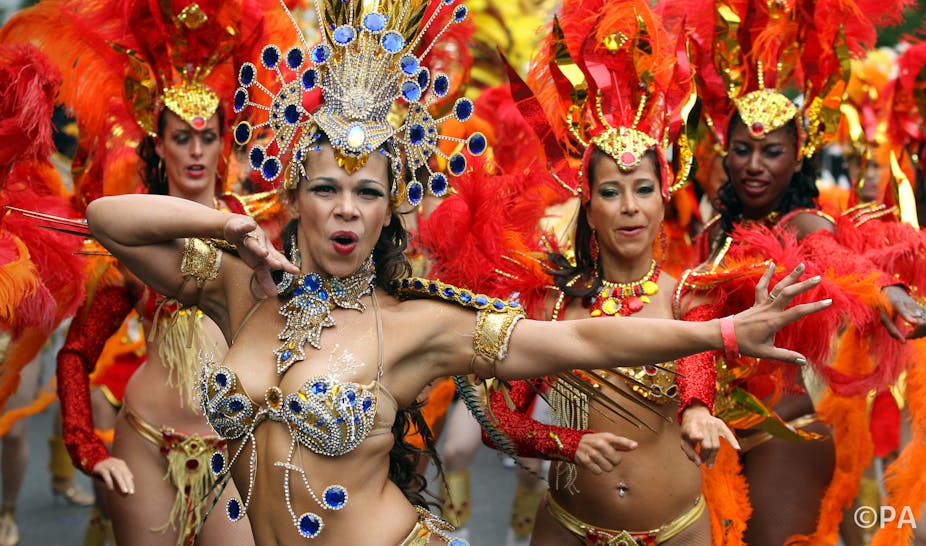This bank holiday weekend, London celebrates yet another glorious Notting Hill Carnival. Relatively few of the hundreds of thousands (if not millions) of revellers enjoying the festivities appreciate the extraordinary process that has led to this festival being dubbed “Europe’s biggest street party.”
Some may be familiar with its predecessor, the Notting Hill Festival. In the 1960s it was waning in popularity, until 1964, when a British social worker, Rhuane Laslett, decided to add a steel band to the festival. Steel bands are formed of players of steel pans – instruments which are indigenous to the Caribbean island of Trinidad and part of its Carnival. Laslett’s intervention caused the Trinidadian immigrants living in Notting Hill to spontaneously form a jumping and dancing procession behind the steel band. Thereafter the Notting Hill Festival became known as the Notting Hill Carnival and the rest, as they say, is history.
Thanks to numerous media reports which tend to highlight the event’s crime statistics, most are familiar with the violent incidents that have occurred at the Notting Hill Carnival. Even though these incidents are a constant source of criticism for festival organisers, they are also in some measure symbolic of the Afro Caribbean community’s struggle for racial equality and recognition in the United Kingdom.
Roots
The exact date when carnival celebrations began on the island of Trinidad is not known but we know these practises only began after the arrival of French slave owners around 1783. The early celebrations were upper class affairs for the slave owners and their friends, but slaves attached to plantations were also allowed to hold their own carnival celebrations. These slave celebrations led to the infusion of African traditions into the Trinidad Carnival.
Trinidad-style carnivals possess three distinct cultural forms. Masquerade is the oldest of the traditions, which was imported from Europe and introduced to Trinidad by French plantation owners. Calypso is next oldest art form, developed during slavery by the African slaves. The steel pan was invented fairly recently by comparison, and steel pan music and was only widely played in Trinidad after 1945.
Carnival as business
The first Trinidad-style carnival celebrations staged outside of Trinidad occurred in Harlem in the 1920s. These would go on to become the New York Labour Day celebrations in 1947. New York’s Labour Day (now called the West Indian American Parade Day), has spawned dozens of other Trinidad-style carnivals in other American cities.
They tend to feature an American-styled parade and are typically devoted to celebrating a “West Indian American” or “Caribbean American” identity. A similar pattern of adaptation and replication can be seen in Canada, where Toronto’s Caribana (started in 1967 and now called Scotia Caribbean Carnival) went on to inspire Montreal’s Carifiesta, Calgary’s Carifest and Ottawa’s Fete-Caribe.
The Notting Hill Carnival is yet another link in this festival network. It has gone on to inspire dozens of carnivals in a host of UK cities, and has the distinction of introducing static sound systems to the carnival celebrations, a practice started by Jamaican DJs living in the UK in 1975. Additionally, it is the only Trinidad-style carnival outside of the Caribbean that has gone on to inspire the establishment of Trinidad-style carnivals outside of its host country. German festival organisers of the Carnivals of Cultures cite the Notting Hill Carnival as a key influence.
This spread of carnivals across the world highlights the increasing prevalence of culture as business export. The remarkably close-knit community of Notting Hill Carnivalists (as they are known) participate not only in the Notting Hill Carnival but a host of UK, European and other carnivals. This allows the community, which has a relatively small resource base, greater reach than it would have otherwise.
Many are continually astounded that an event as large as Notting Hill Carnival continues to happen every year largely due to the efforts of a group of enthusiastic volunteers, with limited support from the public and private sector. The fact these volunteers are able to work collaboratively to support, sustain and create a network of dozens of similar festivals is even more amazing.

